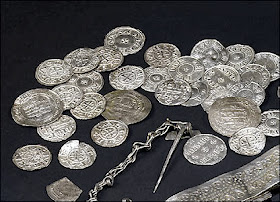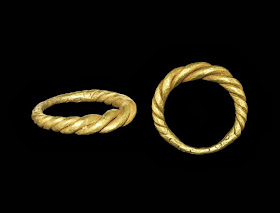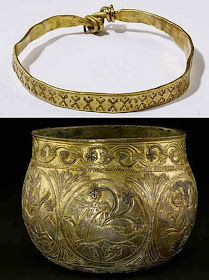Pages
▼
Viking Gold Finger Rings
Viking Gold Scutiform Ring - 9th-11th century AD. A substantial gold finger ring with lozengiform bezel developing from the hoop, formed from a single cast bar; the narrow ends of the bar twisted over each other; the hoop decorated with sub-triangular and pellet-in-triangle punchmarks; the bezel formed with a central boss surrounded by subtriangular and chevron punchmarks.
Viking Gold Plaited Finger Ring- 9th-11th century AD. A ring formed from four rods plaited, joined at the reverse and the ends wound about each other.
Viking Gold Cross-Stamped Finger Ring- 9th-11th century AD. A penannular flat-section finger ring with coiled ends, three bands of cross punchmarks to the hoop, in vertical and diagonal alignment.
Viking Gold Twisted Finger Ring- 9th-11th century AD. A round-section hoop formed as continuous twisted rods, thicker at the bezel.
West Yorkshire Hoard: What Was Found
What was Found?
Seven pieces make up this fantastic Hoard, many of which are in superb condition after all of this time. A little more about each piece…
Cabachon Ring – An unusually large, complete and spectacular gold ring with a lozenge-shaped bezel set with a garnet gem. Anglo-Saxon pieces of such high quality are extremely rare. It was made to be displayed as a sign of great wealth and status and is in near perfect condition.
Filigree Ring – A very attractive and complete ring with filigree decoration, in excellent condition. Two panels of six filigree scrolls are each separated by a fine filigree line bisecting the bezel. Gold pellets sit in the centre of each scroll and in some of the angles between them.
Niello Finger Ring – A rich and heavy complete gold ring with four enlarged, oval sections decorated with floral and zoomorphic motifs on niello background. The ring is complete and in excellent condition. The designs on the panels, especially the crouching animals, are typical of Trewhiddle Style decoration.
Filigree and Granular Ring – A stunningly beautiful and unusually large gold ring with a round bezel and filigree and granular decoration. The ring is complete and in excellent condition. On the bezel, inside two beaded frames and one upright frame, follow short sections of wire imitating a twisted cable surrounding four spirals held by grooved collars and embellished with gold granules.
Cloisonné Piece - A gold fragment from a once-fine brooch, with elaborate cloisonné cells once containing inlays. One side of the triangular fragment is formed by the beaded rim and another looks like it was torn off the original object. The third side was cut in antiquity. This type of brooch dates to the 7th century.
Gold Ingot – A gold ingot (hack gold), cut down in size in antiquity to probably half its original size. The underside shows impressions from the open-top mould, and the criss-cross pattern on the top is a result of the cooling of the metal, which leads to the formation of crystals. It dates to the Viking period (late 9th to 11th centuries).
Spindle Whorl – A flat lead spindle whorl with a central perforation, found about 4-5 inches from the ring. A spindle whorl would have been used in spinning and producing yarn.
Seven pieces make up this fantastic Hoard, many of which are in superb condition after all of this time. A little more about each piece…
Cabachon Ring – An unusually large, complete and spectacular gold ring with a lozenge-shaped bezel set with a garnet gem. Anglo-Saxon pieces of such high quality are extremely rare. It was made to be displayed as a sign of great wealth and status and is in near perfect condition.
Filigree Ring – A very attractive and complete ring with filigree decoration, in excellent condition. Two panels of six filigree scrolls are each separated by a fine filigree line bisecting the bezel. Gold pellets sit in the centre of each scroll and in some of the angles between them.
Niello Finger Ring – A rich and heavy complete gold ring with four enlarged, oval sections decorated with floral and zoomorphic motifs on niello background. The ring is complete and in excellent condition. The designs on the panels, especially the crouching animals, are typical of Trewhiddle Style decoration.
Filigree and Granular Ring – A stunningly beautiful and unusually large gold ring with a round bezel and filigree and granular decoration. The ring is complete and in excellent condition. On the bezel, inside two beaded frames and one upright frame, follow short sections of wire imitating a twisted cable surrounding four spirals held by grooved collars and embellished with gold granules.
Cloisonné Piece - A gold fragment from a once-fine brooch, with elaborate cloisonné cells once containing inlays. One side of the triangular fragment is formed by the beaded rim and another looks like it was torn off the original object. The third side was cut in antiquity. This type of brooch dates to the 7th century.
Gold Ingot – A gold ingot (hack gold), cut down in size in antiquity to probably half its original size. The underside shows impressions from the open-top mould, and the criss-cross pattern on the top is a result of the cooling of the metal, which leads to the formation of crystals. It dates to the Viking period (late 9th to 11th centuries).
Spindle Whorl – A flat lead spindle whorl with a central perforation, found about 4-5 inches from the ring. A spindle whorl would have been used in spinning and producing yarn.
The Leeds or West Yorkshire Hoard
Hoards associated with the Anglo-Saxon culture, from the 6th century to 1066, are relatively uncommon. Those that have been found include both hoards of coins and hoards of jewellery and metalwork such as sword hilts and crosses. The West Yorkshire Hoard dates in part back to the 7th Century and is on display at Leeds City Museum.
It is the "most significant find of Anglo-Saxon jewellery" from the area, according to Leeds City Council.
The most spectacular is a gold ring with a lozenge-shaped bezel complete with a garnet gem.
The collection is on loan in Leeds from The British Museum in London and is officially classed as treasure.
The hoard is "highly significant" and shows the presence of "high status" inhabitants around the area, according to the council.
West Yorkshire Hoard - 5 items of 7th to 11th century gold jewellery (a cabachon ring, a filigree ring, a niello finger ring, a filigree and granular ring, and a piece of a cloisonné bracelet), an ingot of gold, and a lead spindle whorl
It is the "most significant find of Anglo-Saxon jewellery" from the area, according to Leeds City Council.
The most spectacular is a gold ring with a lozenge-shaped bezel complete with a garnet gem.
The collection is on loan in Leeds from The British Museum in London and is officially classed as treasure.
The hoard is "highly significant" and shows the presence of "high status" inhabitants around the area, according to the council.
West Yorkshire Hoard - 5 items of 7th to 11th century gold jewellery (a cabachon ring, a filigree ring, a niello finger ring, a filigree and granular ring, and a piece of a cloisonné bracelet), an ingot of gold, and a lead spindle whorl
Viking Gold Neck Rings
Golden neck rings from Ålleberg, Sweden. Dates to the Migration period. On display at The Swedish Museum of National Antiquities.
Harrogate Hoard: Viking Gold
A reminder of our Viking past was recently discovered lurking beneath a Yorkshire field; what is now being called the ‘Harrogate Hoard’ is an archaeological find of global significance. Said by experts to be the most important Viking find in Britain in 150 years, the finders, metal detectorists David and Andrew Whelan, called the discovery a ‘thing of dreams’.
The hoard consists of 617 silver coins and 65 other items, including ornaments, ingots and precious metal, which were hidden in a gilt silver vessel lined with gold (variously identified as a cup, bowl, or pot) made in France or Germany around 900 and decorated with "vines, leaves and six hunting scenes showing lions, stags, and a horse". The lions were lionesses, with no mane. The vessel is thought to have been used to hold communion bread for a wealthy church or monastery in northern France and to have been acquired either in a Viking raid or as tribute.
 |
| The hoard was found by father and son David and Andrew Whelan while metal detecting near Harrogate in 2007. David described the find as a "ball covered with mud". Picture: British Museum Trustees. |
 |
| Some 100 of the 617 coins in the hoard have now been cleaned. Conservators are delighted with their condition. Picture: British Museum Trustees. |
The hoard consists of 617 silver coins and 65 other items, including ornaments, ingots and precious metal, which were hidden in a gilt silver vessel lined with gold (variously identified as a cup, bowl, or pot) made in France or Germany around 900 and decorated with "vines, leaves and six hunting scenes showing lions, stags, and a horse". The lions were lionesses, with no mane. The vessel is thought to have been used to hold communion bread for a wealthy church or monastery in northern France and to have been acquired either in a Viking raid or as tribute.
Viking Gold
Viking gold brooch from Hedeby, Germany
Neck-ring (10th century, Kalmergården, Tissø, Zealand, Denmark). Gold© The National Museum of Denmark
Hiddensee Treasure: Viking Gold
One of the most stunning but lesser known archaeological finds in Germany is the 'Gold Jewellery of Hiddensee', which was discovered by chance in the 19th century on the tiny island in the Baltic. Since their discovery, the sixteen items in the hoard dating from the Viking Age have been presided over by the Kulturhistorisches Museum of the Hanseatic town of Stralsund.
All items of jewellery, including a brooch (fibula), a neck ring and 14 pendants are of pure gold and weigh some 600 g altogether. It is likely the jewellery originally belonged to the family of the Danish King, Harald Gormsson (died ca. 980), better known by his nickname, 'Bluetooth'.
Cross Motif
Undisputed is the connection with the „Viking" animal symbolism. The animal head in the centre could be the head of an eagle or an owl. However, some scientists speak of Greek-Byzantine influences; others see an astonishing similarity to the hammer form of the God Thor (from the northern mythology).
Fibula Motif
The cross in the centre can be evaluated as a Christian symbol. The Viking goldsmith art shows us finest intertwined gold wires, tender rosettes and tiny up-strewn balls of the gold granule. With some imagination one can see snakes with artfully entwined bodies. It could also be four dragon heads facing each other, whose bodies end in two-toed claws.
Neuendorf/Hiddensee, Rügen, Germany. Gold © Jutta Grudziecki, Kulturhistorisches Museum der Hansestadt Stralsund
The Staffordshire Hoard: Biblical Inscription
"Rise up O Lord, and may thy enemies be dispersed and those who hate
thee," reads the Latin inscription on this strip of gold--a fitting bit
of Bible verse for a war-torn place and time, Britain in the Dark Ages
(roughly A.D. 500 to 1000).
The silver gilt strip bearing a Biblical inscription in Latin is one of the most significant and controversial finds in the Staffordshire Hoard.
Rivet holes show that it was originally fastened to another, larger object. We are not yet sure what this was, but it might have been something like a reliquary or the cover of a Bible. A decorative stone, possibly a garnet, was set into the now empty mount at one end of the strip, whilst an animal head adorns the other end.
Incised into each face of the strip is a verse from the Latin Bible (Numbers 10:35). The text is slightly different on the two sides, but it is clear that the outer side is the most important one since the incisions for the letters have been filled with a dark, silver compound known as niello. There are two spelling mistakes in the Latin.
This suitably warlike outer inscription reads (mis-spellings bolded and underlined):
'Surge domine et disepentur inimici tui et fugent qui oderunt te a facie tua'
The text should read:
'Surge domine et dissipentur inimici tui et fugiant qui oderunt te a facie tua'
When translated, the inscription reads “rise up, o Lord, and may thy enemies be scattered and those who hate thee be driven from thy face”.
Michelle Brown, Professor of Medieval Manuscript Studies, has suggested the style of lettering dates from the seventh or early eighth centuries. The relatively crude lettering may have been the work of someone more used to writing on wax tablets.
The silver gilt strip bearing a Biblical inscription in Latin is one of the most significant and controversial finds in the Staffordshire Hoard.
Rivet holes show that it was originally fastened to another, larger object. We are not yet sure what this was, but it might have been something like a reliquary or the cover of a Bible. A decorative stone, possibly a garnet, was set into the now empty mount at one end of the strip, whilst an animal head adorns the other end.
Incised into each face of the strip is a verse from the Latin Bible (Numbers 10:35). The text is slightly different on the two sides, but it is clear that the outer side is the most important one since the incisions for the letters have been filled with a dark, silver compound known as niello. There are two spelling mistakes in the Latin.
This suitably warlike outer inscription reads (mis-spellings bolded and underlined):
'Surge domine et disepentur inimici tui et fugent qui oderunt te a facie tua'
The text should read:
'Surge domine et dissipentur inimici tui et fugiant qui oderunt te a facie tua'
When translated, the inscription reads “rise up, o Lord, and may thy enemies be scattered and those who hate thee be driven from thy face”.
Michelle Brown, Professor of Medieval Manuscript Studies, has suggested the style of lettering dates from the seventh or early eighth centuries. The relatively crude lettering may have been the work of someone more used to writing on wax tablets.
















